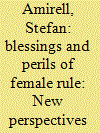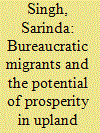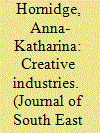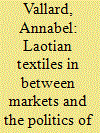|
|
|
Sort Order |
|
|
|
Items / Page
|
|
|
|
|
|
|
| Srl | Item |
| 1 |
ID:
108976


|
|
|
|
|
| Publication |
2011.
|
| Summary/Abstract |
Only in a handful of cases in world history has female rule been seen by contemporary observers as desirable and been sustained for long periods of time. Drawing on European, Malay and Chinese sources, this article investigates the reasons for the institutionalisation of female rule in the Malay sultanate of Patani (presently in southern Thailand) for most of the period between c. 1584 and 1711. It is concluded that the results of previous research, in which the Patani queens are characterised as powerless front figures and/or promiscuous, have insufficient support in the contemporary sources. Furthermore, the problems of female rule for dynastic stability are discussed comparatively. Finally, the decline of female rule in Patani after the mid-seventeenth century is explained with reference to the larger political, economic and military changes in maritime Southeast Asia at the time.
|
|
|
|
|
|
|
|
|
|
|
|
|
|
|
|
| 2 |
ID:
108968


|
|
|
|
|
| Publication |
2011.
|
| Summary/Abstract |
This paper argues that Lao bureaucrats who migrate to the uplands offer possibilities for re-thinking the immutability of upland-lowland distinctions and the power of the modern state. The specific focus is on low-ranking government officials on the Nakai Plateau in central Laos who are positioned at the nexus of state authority, development schemes and the rural poor. Nakai is a site of nationally significant resource utilisation and practices that has provided a model for development across the country. Officials' experiences in Nakai suggest that the upland-lowland contrast can provide valuable understandings of power when combined with an awareness of social processes that reproduce and shift the meanings ascribed to these nominally distinct domains. Significantly, the experiences of mobile marginal officials highlight an idea of state power as the potential to grant prosperity.
|
|
|
|
|
|
|
|
|
|
|
|
|
|
|
|
| 3 |
ID:
108971


|
|
|
|
|
| Publication |
2011.
|
| Summary/Abstract |
On 31 December 1985, Singapore left the United Nations Educational, Scientific and Cultural Organization (UNESCO), turning against the 'New International Information Order' demanded by UNESCO at that time. In October 2007, after 22 years of absence, Singapore rejoined UNESCO, looking for an intensification of cultural and scientific exchange. Taking this example of reviving co-operation between Singapore and UNESCO, this paper assesses the concept of 'creative industries' as a boundary concept that allows for increased co-operation between players with generally opposing knowledge concepts - as manifested in their respective knowledge and cultural politics. The paper starts with a conceptual discussion on the crossing of boundaries. This is followed by an assessment of first, UNESCO's and second, Singapore's gradual repositioning towards culture. While UNESCO turned from distinctly separating 'culture' and 'market' in the 1970s and 1980s to an increased openness for profit-oriented conceptualisations of culture today, Singapore identified the economic potential of culture, creativity and the arts, and therefore the need to foster these as part of its development into a knowledge-based economy. The underlying differences in interests and the orientation of content, expressed by the traditionally opposing conceptualisations of knowledge and culture, are still valid today, yet the concept of 'creative industries', adopted by both sides, seems to offer a common meeting ground. It acts clearly as a bridge, and hence a boundary concept, allowing for an intensification of mutual co-operation. This is discussed in the final part of the paper.
|
|
|
|
|
|
|
|
|
|
|
|
|
|
|
|
| 4 |
ID:
108969


|
|
|
|
|
| Publication |
2011.
|
| Summary/Abstract |
The policies of the United Nations Educational, Scientific and Cultural Organization (UNESCO) related to heritage preservation and promotion have been spreading worldwide for the past few decades. This ethnographically focused paper examines two UNESCO devices, the Crafts Prize and the Awards of Excellence for Handicrafts, as they apply to the contemporary Laotian textiles scene. It questions in particular the uses and values locally assigned to these international certifications of excellence and their mobilisation in the commoditisation of fabrics. On a larger scale, it considers what those devices reveal and entail regarding a 'traditional' handicraft that is, from now on, entangled between trade and the 'politics of culture'.
|
|
|
|
|
|
|
|
|
|
|
|
|
|
|
|
| 5 |
ID:
108974


|
|
|
|
|
| Publication |
2011.
|
| Summary/Abstract |
This paper provides a critical historical analysis of the Muhammadiyah movement in Singapore. I argue that four processes have been crucial in the emergence and sustenance of the Muhammadiyah within a predominantly non-Muslim society: the symbiotic relationship between the leaders and their followers, the formulation and subsequent reformulation of the ideology of the movement, political opportunities which were judiciously exploited and the availability of a wide array of infrastructures. The Muhammadiyah, as will be shown, provides an informative example of an Islamic movement in Southeast Asia that has transcended the challenges faced by the minority Muslim population by making effective use of the limited resources at its disposal.
|
|
|
|
|
|
|
|
|
|
|
|
|
|
|
|
| 6 |
ID:
108965


|
|
|
|
|
| Publication |
2011.
|
| Summary/Abstract |
This article draws upon recently-gathered anthropological and other data from Cambodia to explore how some Cambodians move beyond the constraints of social differentiation and order to access higher realms of meaning. This enables communion, security and liberation from social patterns of misrecognition. Gender is one of the primary principles of social differentiation and in recent years the relationship between gender, security and development has attracted the interest particularly of feminist scholars. Attention is often focused upon the misogynistic aspects of gender differentiation. Proponents of this kind of discourse tend not to concern themselves with how women and men may actually transcend rather than challenge gender order or with how they may commune with one another in ways that generate security. Focusing instead on the notions that are meaningful to the members of a given society may reveal some of the shortcomings of current security, development and feminist discourse. The material presented here is analysed by adapting some of the ideas that Roy Rappaport developed in his study of the 'cognized models' and liturgical rituals of the Maring of New Guinea. Rappaport's model helps to reveal how, by navigating multiple and overlapping levels of meaning, Cambodians may negotiate and even invert social order in ways that can be transformative, emancipatory and healing.
|
|
|
|
|
|
|
|
|
|
|
|
|
|
|
|
|
|
|
|
|